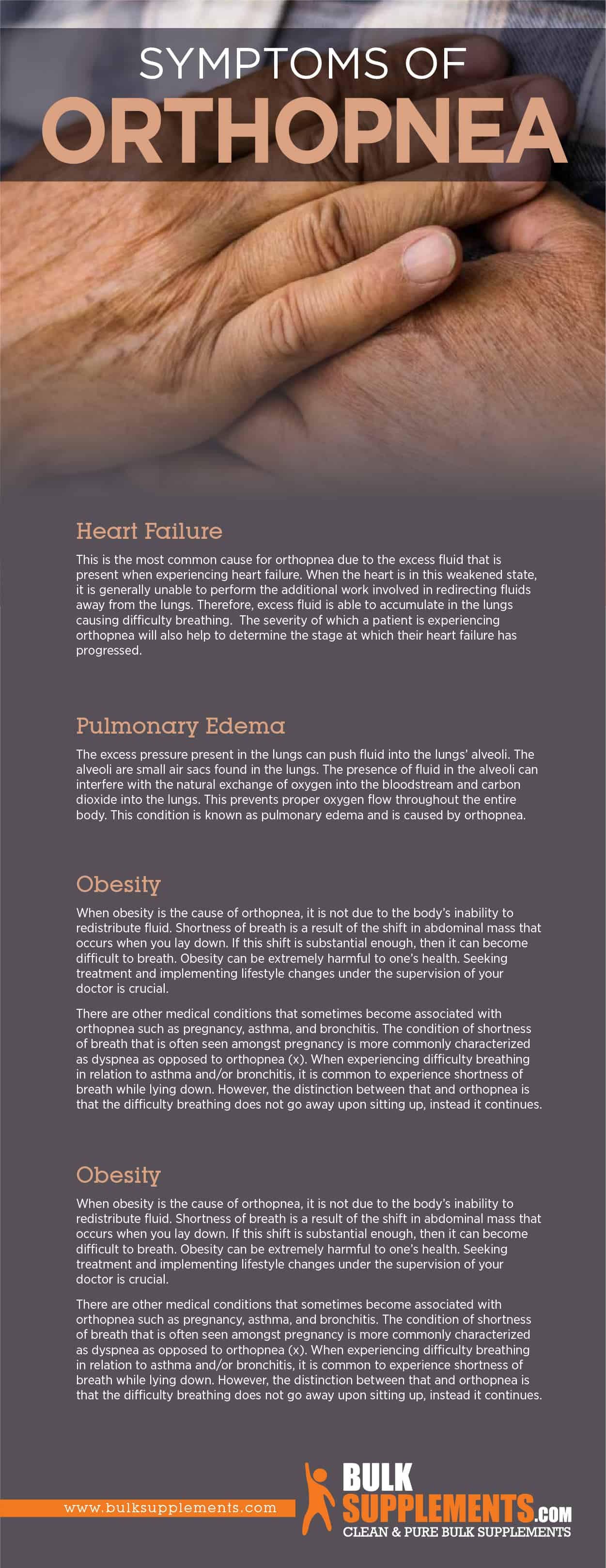Orthopnea: Characteristics, Causes & Treatment

Orthopnea
Shortness of breath is normal during certain physical activities. However, it’s rather alarming when it occurs regularly without being onset by physical activity. Some people experience difficulty breathing specifically when lying down. Others may experience it when standing or while doing normal day-to-day activities. Although all of these scenarios are related, they are symptoms of different medical conditions and have differing causes.
Understanding the cause of shortness of breath can help ease the anxiety related to the experience. More importantly, though, it will likely aid in one’s ability to treat the condition properly.
It is essential to acknowledge that orthopnea (shortness of breath while lying down) is not a normal condition and should be investigated as soon as possible. There are a number of serious health conditions that likely cause shortness of breath, so working closely with a doctor to find a diagnosis is paramount.
What is Orthopnea?
Orthopnea, in general terms, is shortness of breath when lying down. When standing upright, though, symptoms become less obvious. Breathlessness can be an uncomfortable sensation and will often wake people in their sleep. Orthopnea should be taken seriously as it is often a sign of underlying health conditions. These conditions most often include heart failure or lung disease, among others.
People often confuse orthopnea with dyspnea, another breathing condition. In essence, dyspnea is when one has difficulty breathing (or shortness of breath). With this, one can conclude that orthopnea’s main symptom is dyspnea, but they are different. Characteristically, they are different in that orthopnea only includes shortness of breath when lying flat.
Being able to identify when symptoms emerge and when they subside is key in knowing if you have orthopnea or not. Knowing its characteristics can help you better communicate with your doctor about your difficulty breathing, leading to a more conclusive diagnosis and treatment.
Orthopnea Characteristics
The signs and symptoms of orthopnea are relatively specific. When suffering from orthopnea, dyspnea or shortness of breath, it will occur within minutes and sometimes instantly upon the act of lying down flat. Most people with orthopnea will have difficulty breathing, coughing or wheezing when in this position. In severe cases, orthopnea symptoms are onset even in a slight recumbent position.
In order to relieve shortness of breath, it may be necessary to prop yourself up to breathe normally. If you experience shortness of breath upon lying down, but can breathe normally almost immediately after lifting your head, sitting up or standing up, you more than likely have orthopnea. In this case, it is best to seek the advice of a medical professional as soon as possible.
The severity of the orthopnea will often be associated with the orthopneic position they begin to experience dyspnea. If a patient simply needs to prop their head up slightly to relieve symptoms, they likely are suffering from a mild case. However, if it is necessary to be sitting up or standing to breathe, then the condition is far worse.
Orthopnea vs. Paroxysmal Nocturnal Dyspnea
It’s easy to confuse orthopnea with paroxysmal nocturnal dyspnea (PND). With PND, patients often experience breathlessness in their sleep. They may also experience coughing and wheezing. In order to relieve symptoms, just as one does in orthopnea, it is important to sit up and continue breathing normally. This is one of the reasons why it is often confused for the same disorder. Both disorders are directly related to fluid distribution within the body when lying down. However, PND is a much more complex disorder than orthopnea. Both require medical attention and proper diagnosis.
Causes of Orthopnea
It is vital to acknowledge that orthopnea is not a standalone condition. It is often a result of an underlying health condition, usually one that requires medical attention immediately. In most cases, it occurs due to left-side heart failure, but it may also have a connection to lung disease, obesity, pulmonary edema and even pregnancy. The direct cause of orthopnea symptoms is due to the bodies ineffectiveness to redistribute fluid upon lying down. This excess amount of fluid will increase the pressure in the lungs’ blood vessels, making it difficult to breath.
Heart Failure
This is the most common cause for orthopnea due to the excess fluid that is present when experiencing heart failure. When the heart is in this weakened state, it is generally unable to perform the additional work involved in redirecting fluids away from the lungs. Therefore, excess fluid is able to accumulate in the lungs causing difficulty breathing. The severity of which a patient is experiencing orthopnea will also help to determine the stage at which their heart failure has progressed.
Pulmonary Edema
The excess pressure present in the lungs can push fluid into the lungs’ alveoli. The alveoli are small air sacs found in the lungs. The presence of fluid in the alveoli can interfere with the natural exchange of oxygen into the bloodstream and carbon dioxide into the lungs. This prevents proper oxygen flow throughout the entire body. This condition is known as pulmonary edema and is caused by orthopnea.
Obesity
When obesity is the cause of orthopnea, it is not due to the body’s inability to redistribute fluid. Shortness of breath is a result of the shift in abdominal mass that occurs when you lay down. If this shift is substantial enough, then it can become difficult to breath. Obesity can be extremely harmful to one’s health. Seeking treatment and implementing lifestyle changes under the supervision of your doctor is crucial.
There are other medical conditions that sometimes become associated with orthopnea such as pregnancy, asthma, and bronchitis. The condition of shortness of breath that is often seen amongst pregnancy is more commonly characterized as dyspnea as opposed to orthopnea. When experiencing difficulty breathing in relation to asthma and/or bronchitis, it is common to experience shortness of breath while lying down. However, the distinction between that and orthopnea is that the difficulty breathing does not go away upon sitting up, instead it continues.

Orthopnea Remedies and Supplements
Treating orthopnea can be difficult because of the various underlying health conditions that cause it. Once you experience orthopnea, it is important to seek medical attention for proper diagnosis in order to identify the cause. After that, the treatment will vary depending on the health condition causing it and the severity of the orthopnea experienced. Still, there are a number of different home remedies that may be of use. The most common at home treatments for symptoms related to orthopnea include:
SEE ALSO

G6PD (Glucose-6-Phosphate Dehydrogenase) Deficiency: Causes, Symptoms & Treatment
Vitamin C
Adding more vitamin C to your diet or implementing specific doses as a dietary supplement can relieve symptoms of orthopnea. Vitamin C helps to promote immune function and is a powerful antioxidant. You can also pursue vitamin C naturally through certain fruits and vegetables.
Peppermint
Peppermint is a common flavoring in many different forms, including teas and as a dietary supplement. It has long been used to soothe upset stomachs, though it can also help in relieving orthopnea due to its antioxidant properties.
Eucalyptus
This is specifically used to ease breathing when using eucalyptus oil in a humidifier. It can promote fluid movement and make breathing much easier. One can also apply it as an essential oil when diluted to the skin.
Other Dietary/Lifestyle Changes
Combating a disease such as heart disease has a lot to do with genetics, but it is also strongly connected to diet and general lifestyle. Consider discussing with your doctor and consulting dietary specialists to implement other lifestyle changes that may be necessary in order to stop the progression of heart disease.
The easiest and most common way to ease symptoms related to orthopnea is to prop yourself up when lying down and/or going to sleep. Sometimes this will mean you will have to sit in a chair to sleep or use extra pillows to prop your head up more. Simply find the position in which your symptoms subside and go from there. Over time, if your underlying health condition improves, you may be able to decrease the angle in which your body needs to be propped. It is very important to keep in mind that since the underlying health condition is usually heart failure, the focus should be treating that health condition specifically. There are steps you can take to ease symptoms of orthopnea, but unless the underlying condition is addressed, it will not improve. Basically, upon the treatment of heart disease, one of the goals should be to eliminate orthopnea.
The Bottom Line
Experiencing any disorder that makes breathing difficult can be scary. Understanding that orthopnea is usually a symptom of another health concern can either add to or eliminate some of that anxiety.
Once diagnosed, it will be easier to implement small lifestyle changes to ease any symptoms associated with orthopnea. The severity can increase or decrease over time depending on the diligence in which you pursue treatments.



